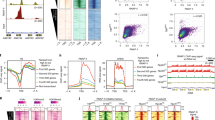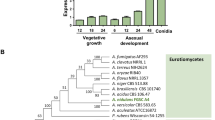Abstract
Production of ergot alkaloids in the opportunistic fungal pathogen Aspergillus fumigatus is restricted to conidiating cultures. These cultures typically accumulate several pathway intermediates at concentrations comparable to that of the pathway end product. We investigated the contribution of different cell types that constitute the multicellular conidiophore of A. fumigatus to the production of ergot alkaloid pathway intermediates versus the pathway end product, fumigaclavine C. A relatively minor share (11 %) of the ergot alkaloid yield on a molar basis was secreted into the medium, whereas the remainder was associated with the conidiating colonies. Entire conidiating cultures (containing hyphae, vesicle of conidiophore, phialides of conidiophore, and conidia) accumulated higher levels of the pathway intermediate festuclavine and lower levels of the pathway end product fumigaclavine C than did isolated, abscised conidia, indicating that conidiophores and/or hyphae have a quantitatively different ergot alkaloid profile compared to that of conidia. Differences in alkaloid accumulation among cell types also were indicated by studies with conidiophore development mutants. A ∆medA mutant, in which conidiophores are numerous but develop poorly, accumulated higher levels of pathway intermediates than did the wildtype or a complemented ∆medA mutant. A ∆stuA mutant, which grows mainly as hyphae and produces very few, abnormal conidiophores, produced no detectable ergot alkaloids. The data indicated heterogeneous spatial distribution of ergot alkaloid pathway intermediates versus pathway end product in conidiating cultures of A. fumigatus. This skewed distribution may reflect differences in abundance or activity of pathway enzymes among cell types of those conidiating cultures.




Similar content being viewed by others
References
Lorenz N, Haarmann T, Pazoutová S, Jung M, Tudzynski P (2009) The ergot alkaloid gene cluster: functional analyses and evolutionary aspects. Phytochemistry 70:1822–1832
Panaccione DG, Ryan KL, Schardl CL, Florea S (2012) Analysis and modification of ergot alkaloid profiles in fungi. Methods Enzymol 515:267–290
Schardl CL, Panaccione DG, Tudzynski P (2006) Ergot alkaloids—biology and molecular biology. Alkaloids 63:45–86
Wallwey C, Li S-M (2011) Ergot alkaloids: structure diversity, biosynthetic gene clusters and functional proof of biosynthetic genes. Nat Prod Rep 28:496–510
Cole R, Kirksey J, Dorner J, Wilson D, Johnson J Jr, Johnson A, Bedell D, Springer J, Chexal K (1977) Mycotoxins produced by Aspergillus fumigatus species isolated from molded silage. J Agric Food Chem 25:826–830
Panaccione DG, Coyle CM (2005) Abundant respirable ergot alkaloids from the common airborne fungus Aspergillus fumigatus. Appl Environ Microbiol 71:3106–3111
Panaccione DG (2005) Origins and significance of ergot alkaloid diversity in fungi. FEMS Microbiol Lett 251:9–17
Yu J-H (2010) Regulation of development in Aspergillus nidulans and Aspergillus fumigatus. Mycobiology 38:29–237
Coyle CM, Kenaley SC, Rittenour WR, Panaccione DG (2007) Association of ergot alkaloids with conidiation in Aspergillus fumigatus. Mycologia 99:804–811
Gravelat FN, Ejzykowicz DE, Chiang LY, Chabot JC, Urb M, Macdonald KD, al-Bader N, Filler SG, Sheppard DC (2010) Aspergillus fumigatus MedA governs adherence, host cell interactions and virulence. Cell Microbiol 12:473–488
Sheppard DC, Doedt T, Chiang LY, Kim HS, Chen D, Nierman WC, Filler SG (2005) The Aspergillus fumigatus StuA protein governs the up-regulation of a discrete transcriptional program during the acquisition of developmental competence. Mol Biol Cell 16:5866–5879
Coyle CM, Cheng JZ, O’Connor SE, Panaccione DG (2010) An old yellow enzyme gene controls the branch point between Aspergillus fumigatus and Claviceps purpurea ergot alkaloid pathways. Appl Environ Microbiol 76:3898–3903
Unsöld IA, Li S-M (2006) Reverse prenyltransferase in the biosynthesis of fumigaclavine C in Aspergillus fumigatus: gene expression, purification, and characterization of fumigaclavine C synthase FGAPT1. ChemBioChem 7:158–164
Eich E, Pertz H (1999) Antimicrobial and antitumor effects of ergot alkaloids and their derivatives. In: Křen V, Cvak L (eds) Ergot, the genus Claviceps. Harwood Academic Publishers, Amsterdam, pp 441–449
Acknowledgments
This work was supported by Grants 2008-35318-04549 and 2012-67013-19384 from the United States Department of Agriculture, National Institute of Food and Agriculture, and published with permission of the West Virginia Agriculture and Forestry Experiment Station as scientific article number 3175. We thank Sarah Robinson and Katy Ryan for technical assistance and Scott Bowdridge for assistance with microscopy.
Author information
Authors and Affiliations
Corresponding author
Rights and permissions
About this article
Cite this article
Mulinti, P., Allen, N.A., Coyle, C.M. et al. Accumulation of Ergot Alkaloids During Conidiophore Development in Aspergillus fumigatus . Curr Microbiol 68, 1–5 (2014). https://doi.org/10.1007/s00284-013-0434-2
Received:
Accepted:
Published:
Issue Date:
DOI: https://doi.org/10.1007/s00284-013-0434-2




